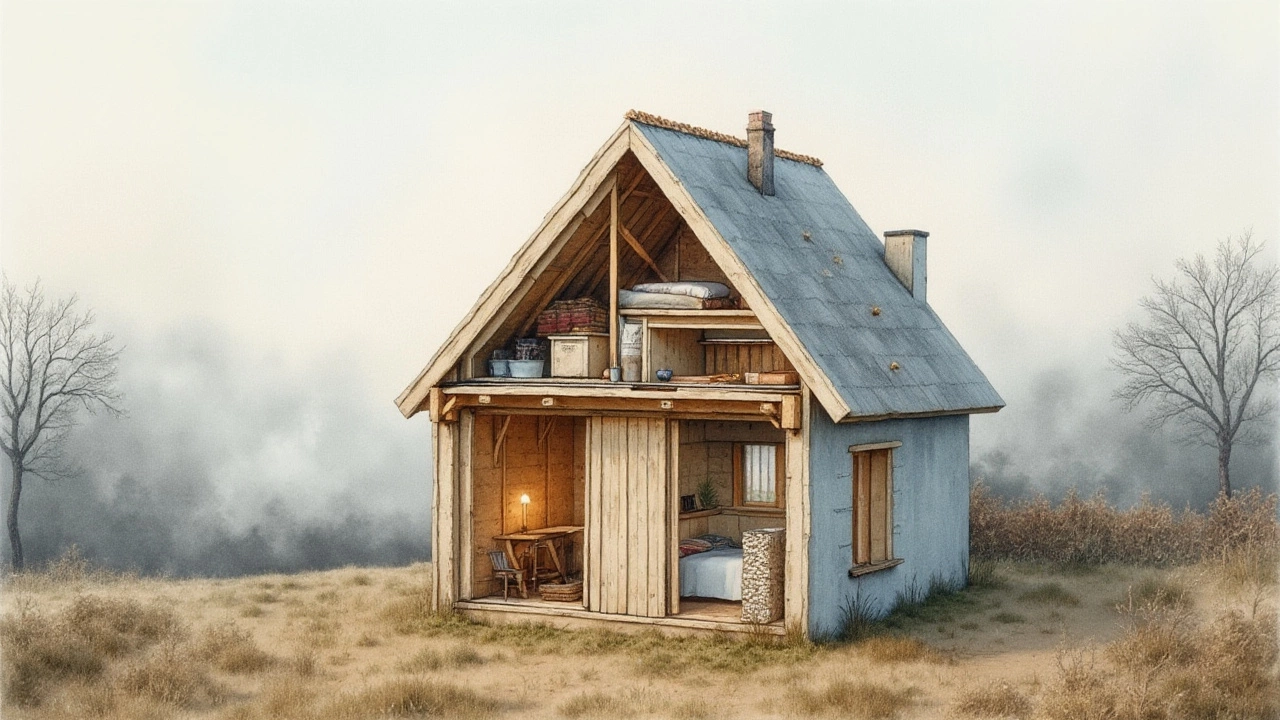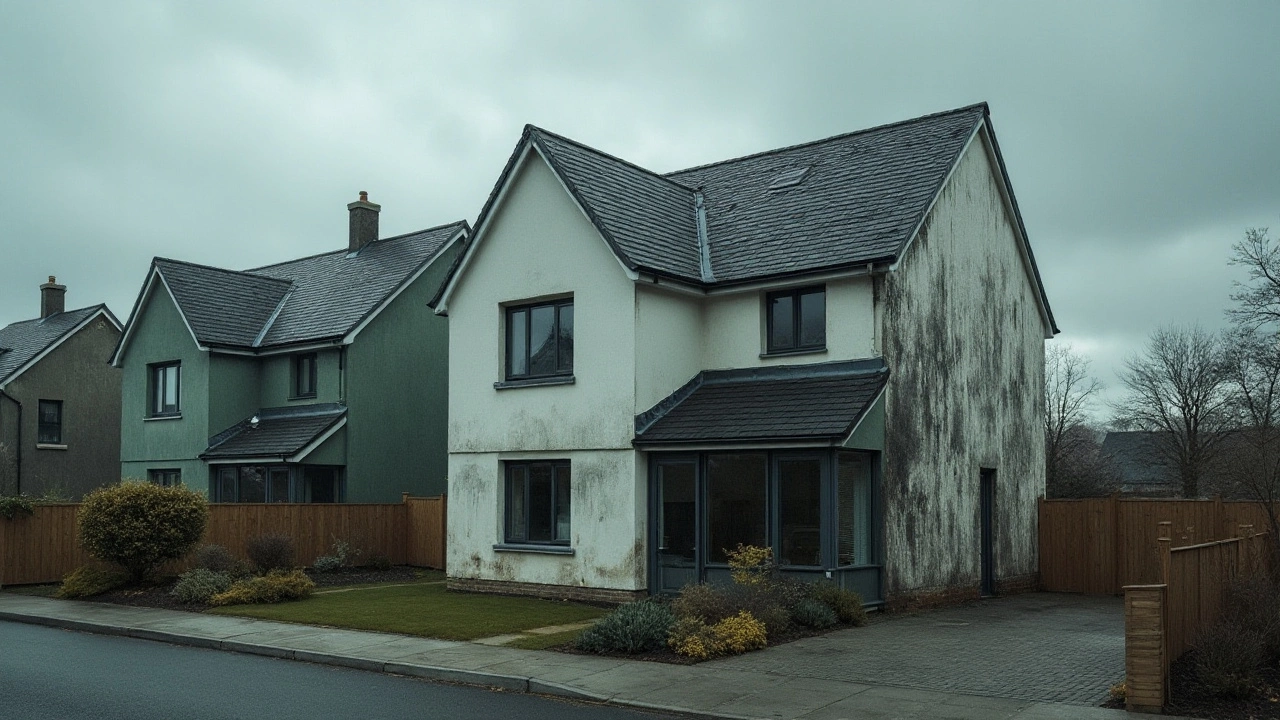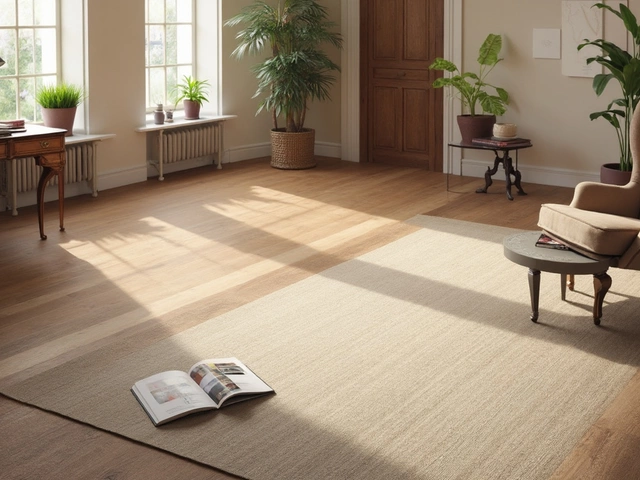Mold is an unwelcome guest that many new homeowners find in their freshly built properties. This isn’t just a problem for older homes; even modern builds are not immune. Understanding why this happens is crucial for potential buyers and those already navigating new homeownership. Mold isn't just an aesthetic issue; it's a potential health hazard that can affect air quality and cause allergic reactions.
New builds might seem like they should be free of such problems, but there are specific reasons why mold takes root even in these brand-new spaces. It’s often due to a combination of hurried construction schedules, insufficient airflow, and environmental conditions that weren’t anticipated during the building process. By familiarizing yourself with these factors, you can take proactive steps to protect your home and your health. Let's take a deeper dive into why these problems occur and what you can do about it.
- Understanding Mold Growth
- Common Mold Triggers in New Builds
- Impact of Construction Practices
- Environmental Factors Contributing to Mold
- Preventative Measures for Homeowners
- Steps to Remedy Mold Issues
Understanding Mold Growth
Mold is everywhere. It’s a type of fungus that thrives in moist environments, and it’s just as at home in a Himalayan cave as it is in your brand-new house. But what exactly makes it tick? At the root of it, mold requires a few key ingredients to flourish: moisture, warmth, and a food source. In the context of a new build, usually, wood, drywall, and other building materials serve as the perfect buffet for mold spores. Once these spores land on a damp surface, they can start to grow and spread rapidly, paving the way for widespread infestation.
It’s fascinating to consider how something as seemingly mundane as mold has such a knack for finding its way into even the most pristine environments. Construction processes that span seasons—particularly those starting in wet months—are at a higher risk. The leftover moisture within building materials or from seasonal rains provides mold with its primary requirement. A combination of factors, such as lack of proper ventilation or heating, can exacerbate these conditions, unknowingly creating a molasses of perfect conditions for mold spores to flourish.
Resistance is Futile?
Many homeowners mistakenly believe new builds are immune to such issues. After all, they are new, constructed with cutting-edge materials and techniques. However, even these seemingly impervious structures can bear the brunt of mold, largely due to fast-paced construction. A 2019 survey by the National Association of Home Builders highlighted that 30% of newly built homes reported mold issues within the first year of occupancy. That’s not just bad luck; it’s a fundamental oversight in understanding how mold behaves."Mold isn’t just opportunistic; it’s pervasive," says Dr. Emily Harper, a renowned mycologist. "Once it finds a way into your environment, it will exploit every crevice, every moisture pocket, to spread. Whether it’s a mansion or a modest bungalow, mold doesn’t discriminate."
The Hidden Details
The tricky thing with mold is its ability to go unnoticed. Mold prefers dark, damp spaces, often growing behind walls or under floors, making it tough to detect until it's too late. By the time the telltale earthy, musty odor raises alarms, what lies below sight could be a sprawling colony. Couple that with the increased air tightness in new builds, aimed at higher energy efficiency, and you end up inadvertently aiding and abetting mold growth. These seals can often trap moisture, leaving it with nowhere to go.Addressing potential mold problems in new construction requires a multifaceted approach. This involves monitoring humidity levels and ensuring adequate airflow. For areas that are inherently damp, such as basements, installing dehumidifiers can be a preventive step. Early detection is crucial. Professionals trained in detecting mold use specialized equipment to gauge moisture levels in walls and ceilings and can provide invaluable help in tracking potential trouble spots before they escalate into full-blown issues.
Common Mold Triggers in New Builds
When moving into a freshly constructed house, the last thing one expects is to deal with mold. Yet, this inconvenience is more common in new builds than many realize. One primary trigger is moisture intrusion, which can occur from several angles during construction. Often, builders work through various weather conditions and might unintentionally seal in moisture when finalizing structural elements, leading to a perfect breeding ground for mold. Oversights in properly sealing roofs or repairing minor leaks in the early stages can result in significant issues down the line.
An additional factor is improper ventilation, a frequent oversight in new buildings due to design preferences for energy efficiency. Modern homes are built to be airtight to conserve energy, but this can backfire when homes lack adequate ventilation systems. Without a way for air to circulate properly, humidity levels can rise indoors, creating an environment where mold can thrive. Even seemingly minor oversights like not installing bathroom or kitchen vents correctly can potentiate mold growth.
Another pervasive trigger is the use of new materials that retain moisture. Many building materials used today, like certain types of drywall, wood, and advanced composites, are more susceptible to harboring mold spores if they become damp. If a home sits unoccupied for extended periods post-construction, oversight or a lack of timely inspection can lead to unchecked mold growth. Attention to detail is key during these phases to prevent such outcomes.
Gregory West, a respected mold remediation expert, once noted, "It's not about avoiding water entirely, but about managing it. Builders need to be vigilant about potential water traps in new constructions."
Moreover, environmental factors and location-specific weather conditions can play a pivotal role. Regions prone to heavy rain or high humidity levels require builders to adopt additional protective measures, often overlooked in the race to meet construction deadlines. Inadequate insulation and sealing of homes in such climates can accelerate mold issues.
An overlooked trigger is the rapid pace of construction itself. There's immense pressure and incentive for builders to meet deadlines, often compromising crucial drying times needed between various construction phases. Materials might be placed too soon on undried areas, which can trap moisture in walls and flooring. A thorough, slower process might be more beneficial in the long haul to ensure that every aspect of the home is sufficiently dried and risk-managed.
Identifying these hidden triggers can save homeowners from potential damage and health issues caused by mold. By understanding and addressing these common causes associated with mold in new builds, both prospective and current homeowners can take steps to ensure their living spaces remain healthy and safe. Proactive measures are crucial in safeguarding a new home from these often underestimated risks.
Impact of Construction Practices
The way new homes are constructed can have a significant effect on why mold finds its way into these structures. One of the main contributors is the haste with which many new properties are built. Fast-paced construction schedules are not uncommon, driven by developers eager to meet demand and turnover properties quickly. In doing so, some critical steps can be overlooked or rushed. For example, inadequate time is often allowed for materials to thoroughly dry before other components are added, which can trap moisture within the walls, flooring, and ceilings. When this hidden moisture meets the right conditions, mold growth can begin almost unnoticed.
Another factor within construction practices that leads to these problems is the choice of materials. Modern builds frequently use materials that are more cost-effective and efficient in terms of insulation. While these materials are excellent at keeping energy costs down and maintaining internal temperatures, they can also be less breathable than traditional building materials. This scenario contributes to higher humidity levels inside the home—a perfect breeding ground for mold. It's crucial that builders account for ventilation to offset this effect.
Moreover, a noticeable aspect of new construction is the building techniques themselves. Contemporary designs often prioritize the aesthetic and functional elements over practical considerations like humidity management. And when homes are sealed tightly to increase energy efficiency, it sometimes means natural airflow is restricted, preventing moisture from escaping. This can inadvertently create a humid environment within the house that, combined with the moist materials, results in mold proliferation.
In support of these points, building codes in some regions are trying to adapt to these modern challenges. Yet, implementation is inconsistent, and adherence relies heavily on the integrity and knowledge of the builders and contractors involved. A case study in 2023 found that homes built with a delay in the installation of drywall and flooring until concrete and other foundational materials had dried completely experienced far fewer issues with mold.
"New building techniques need to account for the climatic moisture levels typical of their regions more effectively than they currently do," says a prominent architect from a leading construction firm, highlighting the area for improvement in this industry.In the absence of standardized regulations across the board, homebuyers often need to take matters into their own hands, ensuring that the builders they choose follow best practices for moisture management.

Environmental Factors Contributing to Mold
When it comes to new builds, pointing fingers at construction practices alone paints an incomplete picture. The environment, an often overlooked player, has a considerable role in the proliferation of mold. Geographical location is a primary factor. Homes built in areas with high humidity or excessive rainfall face an increased risk of mold growth. This is simply because mold thrives in damp and moist conditions, and even modern construction methods can sometimes struggle to keep that moisture at bay.
Consider climates where thunderous rainfalls are the norm. Such weather patterns make it challenging for homes to dry out completely, especially during construction phases. When moisture is trapped within the building materials or structural cavities, it doesn’t take long for mold to sneak in and start growing. Construction sites often begin exposing raw materials to moisture before they are sealed in, creating perfect conditions for mold from the ground up.
A change in climate patterns is another angle to discuss. Rising global temperatures have been linked to more unpredictable weather conditions, which in turn affects humidity levels in areas previously less impacted by moisture concerns. A sudden spike in local humidity can overwhelm existing moisture barriers, leaving even new constructions vulnerable. A report from the Environmental Protection Agency details how these shifts are increasing the potential for more frequent moisture-related issues in new housing developments.
"Humidity control is essential for effective mold prevention," highlights the EPA, emphasizing the need for builders and homeowners alike to foresee these challenges early in the planning stages.
Solar orientation—how a home is positioned relative to the sunlight—also factors into the mix. Homes that lack proper sunlight exposure often don't dry out sufficiently, retaining moisture in shaded areas. This is particularly problematic in densely populated areas where achieving optimal positioning might conflict with other architectural considerations. Ensuring bright, open spaces isn’t always plausible, but enhanced window placement or using materials designed to handle persistent shade can serve as valuable contingencies.
Mold can also take advantage of homes located near bodies of water. Proximity to lakes, rivers, or even underground water tables can mean higher ambient moisture levels, impacting not just the outside environment, but filtering into homes as well. Interestingly, areas with lush vegetation might seem ideal but can sometimes contribute to mold proliferation due to increased humidity and blocked ventilation.
Natural wind patterns play into this equation too. Areas that experience considerable airflow naturally help moisture evaporate more quickly, which reduces the chance of encountering lingering dampness. On the opposite spectrum, those located in stagnant air zones might require technological aids like dehumidifiers to compensate for the lack of natural drying. Construction near coastal areas requires that builders rely heavily on weather-resistant building materials and comprehensive sealing techniques to counteract the persistent influence of sea air—saline-rich and often laden with moisture, yet these can be unforeseen additions to your list of suspects.
Preventative Measures for Homeowners
The prospect of facing mold in a brand-new home can be unsettling, to say the least. However, by adopting some precautionary approaches, homeowners can significantly reduce the risk of mold becoming an issue in their newly constructed homes. More than just quick fixes, these measures involve thoughtful planning and ongoing attention to your living environment. One of the first steps is to ensure that there is adequate ventilation throughout the home. This can mean installing high-efficiency air exchangers or simply ensuring regular use of bathroom and kitchen fans to expel moisture-laden air. Mold thrives in damp environments, so proper air circulation is critical to prevent its growth.
Another crucial approach is managing humidity levels indoors. It is recommended to keep the indoor humidity below 60%, ideally between 30% and 50%. Frequent use of a dehumidifier, especially in moisture-prone areas like the basement or crawlspaces, helps in maintaining these levels. Mold spores are omnipresent in the air; they only require moisture to proliferate. This concept emphasizes why humidity control is paramount. Surprisingly, one additional cost-effective method involves simply being vigilant about leaks and plumbing issues. Regularly checking areas under sinks, behind appliances, and around windows can save future trouble.
For those keen on technology, smart home systems offer a unique advantage by providing real-time monitoring of conditions like humidity and temperature. These systems can alert you to situations ripe for mold growth, even allowing remote control adjustments. Including mold-resistant building materials in your home from the start is another line of defense. Gypsum-based drywall, treated wood, and mold-resistant insulation can be immensely helpful. While these might seem like initial extra costs, they usually translate into long-term savings by keeping mold—and the associated health risks—at bay.
Professional assessment and waterproofing of your home’s foundation can also provide peace of mind, especially in areas prone to heavy rainfall or flooding. “Prevention is not only better, but cheaper than the cure,” as noted by a report from the International Association of Certified Home Inspectors. Their findings indicate that money spent on prevention generally costs significantly less than handling full-scale mold remediation later. Mold prevention requires a proactive mindset, and part of this involves educating everyone in your household about its causes and signs.
If you're already witnessing early signs of mold, rapid action is vital. Basic cleaning with mold-killing solutions may suffice in some cases, but for larger infestations, consulting professionals is advised. Following practical tips and incorporating vigilance, homeowners can preserve the health and safety of their homes, ultimately ensuring that their new build remains a sanctuary free from pervasive mold issues.
Steps to Remedy Mold Issues
Tackling mold in new builds can be a daunting task, but with actionable steps and informed decisions, homeowners can navigate this challenge effectively. It's crucial to begin by identifying the root cause of the mold, which often links back to excess moisture. Moisture can originate from various sources such as leaks, condensation from inadequate ventilation, or even from building materials that weren't dried properly before being enclosed. Pinpointing the exact source is the first step in crafting a durable solution. Start by checking attics, basements, and crawl spaces as these areas are common culprits for harboring moisture. A simple moisture meter purchased from a local hardware store can provide some invaluable insights.
Once you've identified where the mold is thriving, it's time to act. Hiring a professional may be the best step forward, especially for larger infestations. Professionals not only have the right tools but also the expertise to ensure mold is completely removed. Their experience ensures that health risks are minimized, considering molds can potentially release hazardous spores when disturbed. If you're considering a DIY approach for smaller areas, make sure to wear proper protective gear like gloves and masks to avoid contact or inhalation. It's imperative to use a high-quality mold remover and scrub the affected area thoroughly. Post-cleaning, applying a mold sealant can prevent future growth in treated areas.
Improving Ventilation
Enhancing ventilation within the home is another critical remedy. Several new builds suffer from poor air exchange, prompting conditions where molds can flourish. Consider installing energy-efficient fans or ventilation systems in rooms that frequently encounter moisture, such as kitchens and bathrooms. Leaving windows open whenever feasible will further aid in the natural circulation of air throughout the home. The introduction of dehumidifiers can also make a significant difference, especially dealing with humid climates. Keep indoor relative humidity at below 50% to ensure that moisture levels aren't conducive for mold growth.Monitoring Future Risks
"Regular maintenance checks and an eye for early signs are golden rules for mold prevention," recommends Lucas Morrison, a renowned home inspection expert.Staying proactive will save time and expenses long-term. Schedule routine checks with a trusted inspector who knows the ins and outs of new constructions. While professional inspections might seem like a periodic splurge, it's a small price to pay when considering the alternative costs associated with significant mold removal and home repair.
Homeowners should also be aware of the materials used in their home's construction. By choosing mold-resistant materials for future renovations or building projects, one can drastically reduce the risk of mold. These include mold-resistant drywall, paints, and certain lumber treatments. While they might raise immediate costs, the investment typically pays off by safeguarding the home against the pervasive challenges of mold down the line. Armed with this knowledge, you should be able to remedy mold issues effectively and take preventative measures to ensure your home remains mold-free.





